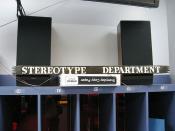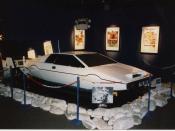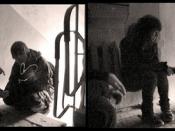The films Dr. No (1962) and Rising Sun (1994) both rely on the use of heroes and stereotypes to tell their story.
The first James Bond movie, Dr. No, is filled with stereotypes that would be considered very politically incorrect today. Although Connery's character is actually representing Great Britain, he is your stereotypical popular American hero. He doesn't possess any superpowers and he doesn't wear a mask and cape, so why is he such an icon? Because he is Secret Agent 007 - an intelligent and attractive white male with a cultivated taste in food and drink (and cigarettes), fighting super-villains all over the world, while getting involved with various beautiful women in the process. The other characters are stereotypical representations of people based on race, class, ethnicity, and gender. All of the black men are represented as either villains, or dumb and harmless helpers of the underworld. In the beginning of the movie we see that it is the three black men that shot and killed a white man and white woman.
Later we are introduced to Quarrel, the Jamaican man who is just represented as a big and harmless dumb islander. Near the end of the movie, Quarrel is killed. It's as if saying that Quarrel has done his job in helping Bond, so now his life must be sacrificed for the white hero. Women are portrayed as being weak and helpless, and often times, "blonde bimbos"�. Bond likes to flirt with the women to get them into bed, and the women will usually always willingly fall under his spell. He also takes charge of them and they follow his every command. Then there is Dr. No who appears to have some Russian or at least multiracial features. And of course back then, it was the Soviet Union who were considered enemies of the free world.
In Rising Sun, our heroes are Lieutenant Web Smith (who is black) and Captain John Connor. They are two "specialized"� officers who have to solve the murder of a beautiful woman. But now, in 1994, instead of black men being the bad guys, it is Japanese businessmen who are seen as deceitful murderers who try to take over U.S. companies with their scheming. The movie doesn't try to explain Japanese culture, tradition or motives at all, but it automatically assumes that the viewer knows the reason why the Japanese are being portrayed this way is because "everyone knows that all Asians are rich scheming businessmen"�.
Many of the women in Rising Sun are tall, sexy, and seductive. Strong-headed women are often seen as villains in films today, or as the "they were asking to get hurt"� character type. Unlike the Bond girls, these women have their own minds and don't take usually take orders from men.
Heroes in popular culture are nice to have because these stories give people a break from their daily boring lives. Stereotypes will always be around no matter how "wrong"� they are, but as time goes on we will just replace old stereotypes with new ones. While Dr. No and Rising Sun tend to use negative stereotypes, they are useful in helping viewers understand the what's and why's of a story.







